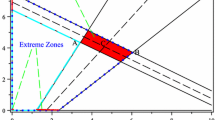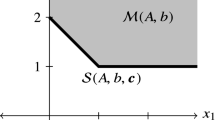Abstract
Several methods exist for solving the interval linear programming (ILP) problem. In most of these methods, we can only obtain the optimal value of the objective function of the ILP problem. In this paper we determine the optimal solution set of the ILP as the intersection of some regions, by the best and the worst case (BWC) methods, when the feasible solution components of the best problem are positive. First, we convert the ILP problem to the convex combination problem by coefficients 0 ≤ λ j , μ ij , μ i ≤ 1, for i = 1, 2, . . . , m and j = 1, 2, . . . , n. If for each i, j, μ ij = μ i = λ j = 0, then the best problem has been obtained (in case of minimization problem). We move from the best problem towards the worst problem by tiny variations of λ j , μ ij and μ i from 0 to 1. Then we solve each of the obtained problems. All of the optimal solutions form a region that we call the optimal solution set of the ILP. Our aim is to determine this optimal solution set by the best and the worst problem constraints. We show that some theorems to validity of this optimal solution set.
Similar content being viewed by others
References
Alefeld G., Herzberger J.: Introduction to interval computations. Academic Press, Orlando, FL (1983)
Chinneck JW., Ramadan K.: Linear programming with interval coefficient. J. Oper. Res. Soc. 51, 209–220 (2002)
Fiedler M., Nedoma J., Ramik J., Zimmermann K.: Linear optimization problems with inexact data. Springer, Berlin (2003)
Hansen E., Walster G.W.: Global optimization using interval analysis, second edition, revised and expanded. Marcel Dekker, New York (2004)
Hladik M.: How to determine basis stability in interval linear programming. Technical report KAM-DIMATIA Series (2010-973), Department of Applied Mathematics, Charles University, Prague (2010)
Hladik M.: Interval linear programming: A survey. In: Mann, Z.A. (ed.) Linear Programming–New Frontiers in Theory and Applications., Nova Science publishers, New York (2011)
Konickova J.: Sufficient condition of basis stability of an interval linear programming problem. ZAMM, Z. Angew. Math. Mech. 81(Suppl.3), 677–678 (2001)
Rex J., Rohn J.: sufficient conditions for regularity and singularity of interval matrices. SIAM J. Matrix Anal. Appl. 20(2), 437–445 (1998)
Rohn J.: Cheap and tight bound: The recent result by E. Hansen can be made more efficient. Interval comput. 1993(4), 13–21 (1993)
Shaocheng T.: Interval number and fuzzy number linear programming. Fuzzy Sets Syst. 66, 301–306 (1994)
Stewart N.F.: Interval arithmetic for guaranteed bounds in linear programming. J. Optim. Theory Appl. 12, 1–5 (1973)
Zhou F., Huang G.H., Chen G., Guo H.: Enhanced-interval linear programming. Eur. J. Oper. Res. 199, 323–333 (2009)
Author information
Authors and Affiliations
Corresponding author
Rights and permissions
About this article
Cite this article
Allahdadi, M., Mishmast Nehi, H. The optimal solution set of the interval linear programming problems. Optim Lett 7, 1893–1911 (2013). https://doi.org/10.1007/s11590-012-0530-4
Received:
Accepted:
Published:
Issue Date:
DOI: https://doi.org/10.1007/s11590-012-0530-4




